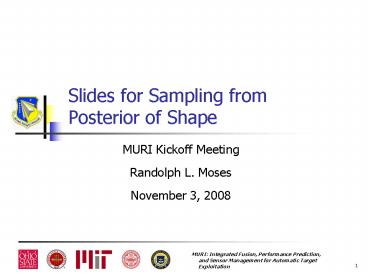Slides for Sampling from Posterior of Shape - PowerPoint PPT Presentation
Title:
Slides for Sampling from Posterior of Shape
Description:
Establishes conditions for detailed balance when sampling from normal ... Analysis of distribution over shape posterior (rather than point estimate such as MAP) ... – PowerPoint PPT presentation
Number of Views:23
Avg rating:3.0/5.0
Title: Slides for Sampling from Posterior of Shape
1
Slides for Sampling from Posterior of Shape
- MURI Kickoff Meeting
- Randolph L. Moses
- November 3, 2008
2
Topics
- Shape Analysis (Fan, Fisher Willsky)
- MCMC sampling from shape priors/posteriors
3
MCMC Sampling from Shape Posteriors
4
MCMC Shape Sampling
- Key contributions
- Establishes conditions for detailed balance when
sampling from normal perturbations of (simply
connected) shapes, thus enabling samples from a
posterior over shapes - Associated MCMC Algorithm using approximation
- Analysis of distribution over shape posterior
(rather than point estimate such as MAP) - Publications
- MICCAI 07
- Journal version to be submitted to Anujs Special
Issue of PAMI
5
Embedding the curve
- Force level set ? to be zero on the curve
- Chain rule gives us
6
Popular energy functionals
- Geodesic active contours (Caselles et al.)
- Separating the means (Yezzi et al.)
- Piecewise constant intensities (Chan and Vese)
7
Markov Chain Monte Carlo
- C is a curve, y is the observed image (can be
vector), S is a shape model - Typically model data as iid given the curve
- We wish to sample from p(xyS), but cannot do so
directly - Instead, iteratively sample from a proposal
distribution q and keep samples according to an
acceptance rule a. Goal is to form a Markov
chain with stationary distribution p - Examples include Gibbs sampling,
Metropolis-Hastings
8
Metropolis-Hastings
- Metropolis-Hastings algorithm
- Start with x0
- At time t, sample candidate ft from q given xt-1
- Calculate Hastings ratio
- Set xt ft with probability min(1, rt),
otherwise xt xt-1 - Go back to 2
9
Asymptotic Convergence
- We want to form a Markov chain such that its
stationary distribution is p(x) - For asymptotic convergence, sufficient conditions
are - Ergodicity
- Detailed balance
10
MCMC Curve Sampling
- Generate perturbation on the curve
- Sample by adding smooth random fields
- S controls the degree of smoothness in field, k
term is a curve smoothing term, g is an inflation
term - Mean term to move average behavior towards
higher-probability areas of p
11
Synthetic noisy image
- Piecewise-constant observation model
- Chan-Vese energy functional
- Probability distribution (T2s2)
12
Needle in the Haystack
13
Most likely samples
14
Least likely samples
15
Confidence intervals
16
When best is not best
- In this example, the most likely samples under
the model are not the most accurate according to
the underlying truth - 10/90 confidence bands do a good job of
enclosing the true answer - Histogram image tells us more uncertainty in
upper-right corner - Median curve is quite close to the true curve
- Optimization would result in subpar results
17
Conditional simulation
- In many problems, the model admits many
reasonable solutions - We can use user information to reduce the number
of reasonable solutions - Regions of inclusion or exclusion
- Partial segmentations
- Curve evolution methods largely limit user input
to initialization - With conditional simulation, we are given the
values on a subset of the variables. We then
wish to generate sample paths that fill in the
remainder of the variables (e.g., simulating
pinned Brownian motion) - Can result in an interactive segmentation
algorithm
18
Future approaches
- More general density models (piecewise smooth)
- Full 3D volumes
- Additional features can be added to the base
model - Uncertainty on the expert segmentations
- Shape models (semi-local)
- Exclusion/inclusion regions
- Topological change (through level sets)
- Better perturbations































